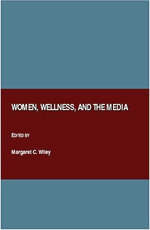Currents: women, wellness, and the media
Professor Margaret Wiley's New Book of Essays Explores the Perils, Politics and Media Manipulation of Women's Health Issues

Plenty of people want to create a book. If they're lucky, they'll find someone who wants to publish it. If they're extraordinarily lucky, someone will actually approach them about creating a book, and then publish it.
Such is the luck of Colby-Sawyer College Assistant Professor of Humanities Margaret Wiley, whose first book, Women, Wellness, and the Media – a collection of 13 essays written by scholars from a variety of disciplines – grew out of a chance encounter with the United Kingdom's Cambridge Scholars Press (CSP) and was published in 2008. CSP is an academic publisher “aiming to promote knowledge and learning through the production and distribution of valuable academic works.”
At the 2005 Annual Northeast Popular Culture Association Conference in Fairfield, Conn., Wiley, a Hanover, N.H., resident and longtime member, moderated a panel discussing three papers: “Smashing: Philip Morris's Successful Promotion of Virginia Slims Cigarettes Through Women's Tennis, 1970-1994” by Martha Gardner of Massachusetts College of Pharmacy and Health Sciences; “Women's Fitness Magazines: Weakness or Wellness? Compliance or Competence?” by Carol-Ann Farkas, also of Massachusetts College of Pharmacy and Health Sciences; and “Cover To Cover: Contemporary Issues in Popular American Women's Magazines” by Debbie Danowski of Sacred Heart University.
The audience response to the panel was phenomenal, Wiley recalls, but she was completely surprised when the publishing house from England asked if she'd be willing to put a book together. “I do have this peculiar background,” she muses. “I can read medical journals and understand them.”
Accepting the assignment bound together two significant areas of Wiley's life – medicine and literature – and focused on her interest in the intersection between culture and healthcare.
Two Worlds Come Together
In the late 1970s, Wiley was a registered nurse in the world's only heart transplant unit; in 1982, she moved to San Francisco just as the AIDS epidemic started to emerge.
“I experienced firsthand how the social construction of disease impacted healthcare,” Wiley writes in her introduction. “Today, the woman in the street is becoming increasingly aware that the health care system has been ignoring many female issues, as evidenced by the preponderance of articles in women's magazines advising readers to become more proactive when seeing their physicians. More recently, scandals surrounding hormone replacement therapy and silicone breast implants have triggered women's awareness that their medical care is affected by cultural construction such as race, class, gender, age and beauty.”
After ten years as a nurse, Wiley, always a reader, decided to switch careers and earned her doctorate in literature. She received a Ph.D. in English Literature at the University of Massachusetts-Amherst in 1997.
For the book, the ultimate exercise in using her perfectly “peculiar” background, Wiley envisioned a collection of essays that would explore the relationship between media stereotypes and women's health and analyze how the “tangled discourses of religion, aesthetics, consumer capitalism and scientific research” determine what is sick and what is healthy. Putting out a call for papers, she included topics that her students had shown interest in, including women and AIDS, lesbian, gay, bisexual and transgender/transsexual health care issues, plastic surgery, minority female health care, pregnancy, aging women, and health in adolescent girls.
“People need to know more about their medical system – for example, U.S. healthcare is the most expensive in the world, but we're ranked 37th for quality. People don't know that. And overwhelmingly, women are more likely to seek health care than men, and half the reasons women seek care for are socially mediated, such as aging and hormone replacement. This is actually incredibly dangerous for most women, as two articles point out.”
A Book Takes Shape
“I got tons of articles and pulled together the ones with the freshest ideas,” she says. “Three of them were the original panel papers. Colby-Sawyer students are very interested in the fact that Food and Drug Administration (FDA) regulates drugs but not cosmetics, which is really shocking when you think about what we put on our bodies. I was really hoping someone would come forth with an article on that, but they didn't. Another topic that students are very interested in, and that I didn't get any article responses to, was the issue of teen magazines and body image and little girls. But, I'm very pleased with the collection that we did get.”
What she got was a collection of essays from scholars ranging from Connecticut to Australia that looked at stereotypes of women, which Wiley summarizes as the perfect mother; the bikini-clad blond teenager who has been air-brushed to perfection; the black Jezebel who struts her stuff; and the menopausal crone. “The writers point out that these images are making millions of dollars for all sorts of businesses ranging from the pharmaceutical industry to women's magazines,” says Wiley on the book's back cover. “Scholars have long noted that stereotypes disempower women; in Women, Wellness, and the Media we see how these stereotypes actually harm women's health while turning millions in corporate profits.”
This was Wiley's first book, and over the course of two summers she pored over each essay, contacting the authors, editing and re-editing. Gender, race and class are the major threads of Women, Wellness, and the Media, issues Wiley says her students are very aware of.
“I probably read each essay 20 times,” she laughs. “But I was intellectually fed by doing this book – pop culture is so entwined with our medical care, yet there's nothing else like Women, Wellness, and the Media on the market. While the book was in progress, two of my students were able to use essays from it for their own research projects. This is exactly what I hoped for the book; I wanted something that an undergraduate in any major would be able to understand and use. It's really, truly interdisciplinary. It was thrilling to have a publisher come to me, and editing this book was a wonderful learning experience.”
Women, Wellness, and the Media is available at the Susan Colgate Cleveland Library, and can be purchased at the Colby-Sawyer Bookstore, on www.amazon.com, or www.c-s-p.org
-Kate Dunlop Seamans, January 2009



